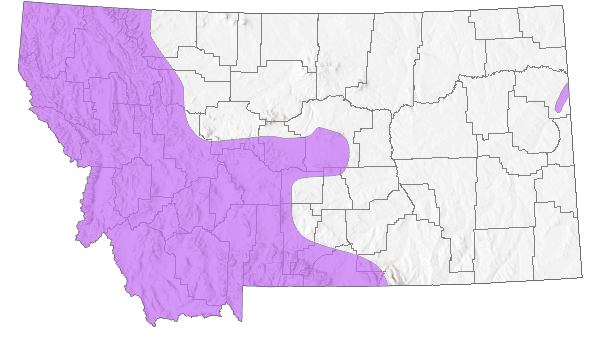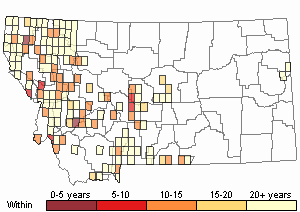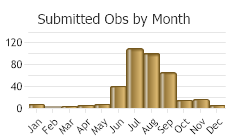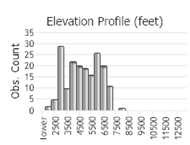View in other NatureServe Network Field Guides
NatureServe
Montana
Utah
Wyoming
Idaho
Wisconsin
British Columbia
South Carolina
Yukon
California
New York
Southern Red-backed Vole - Clethrionomys gapperi
Other Names:
Myodes gapperi
Native Species
Global Rank:
G5
State Rank:
S5
(see State Rank Reason below)
Agency Status
USFWS:
USFS:
BLM:
External Links
State Rank Reason (see State Rank above)
Species is apparently secure and not at risk of extirpation or facing significant threats in all or most of its range.
General Description
The Southern Red-backed Vole has a blunt nose and short ears. It is approximately 6 inches (152 millimeters) long when fully grown. It has buffy gray sides, and a buff-white to silver-gray belly. The wide reddish band which distinguishes it from other mice in Montana traces over its back from the forehead to the base of a short tail.
Diagnostic Characteristics
The distinctive band down the center of the Southern Red-backed Vole's back may be bright chestnut to yellowish brown, rather than reddish brown. Two colors can be seen along the tail, and the head and ears are larger than those of other voles (Zeveloff and Collett 1988).
Species Range
Montana Range
Range Descriptions

 Native
Native
Western Hemisphere Range

Observations in Montana Natural Heritage Program Database
Number of Observations: 442
(Click on the following maps and charts to see full sized version)
Map Help and Descriptions
Relative Density

Recency



 (Observations spanning multiple months or years are excluded from time charts)
(Observations spanning multiple months or years are excluded from time charts)
Migration
Non-migratory.
Habitat
In western MT particularly common in dense subalpine forests, also occurs in more open forest types, even alpine tundra (Hoffmann and Pattie 1968).
Ecological Systems Associated with this Species
- Details on Creation and Suggested Uses and Limitations
How Associations Were Made
We associated the use and habitat quality (common or occasional) of each of the 82 ecological systems mapped in Montana for
vertebrate animal species that regularly breed, overwinter, or migrate through the state by:
- Using personal observations and reviewing literature that summarize the breeding, overwintering, or migratory habitat requirements of each species (Dobkin 1992, Hart et al. 1998, Hutto and Young 1999, Maxell 2000, Foresman 2012, Adams 2003, and Werner et al. 2004);
- Evaluating structural characteristics and distribution of each ecological system relative to the species' range and habitat requirements;
- Examining the observation records for each species in the state-wide point observation database associated with each ecological system;
- Calculating the percentage of observations associated with each ecological system relative to the percent of Montana covered by each ecological system to get a measure of "observations versus availability of habitat".
Species that breed in Montana were only evaluated for breeding habitat use, species that only overwinter in Montana were only evaluated for overwintering habitat use, and species that only migrate through Montana were only evaluated for migratory habitat use.
In general, species were listed as associated with an ecological system if structural characteristics of used habitat documented in the literature were present in the ecological system or large numbers of point observations were associated with the ecological system.
However, species were not listed as associated with an ecological system if there was no support in the literature for use of structural characteristics in an ecological system,
even if point observations were associated with that system.
Common versus occasional association with an ecological system was assigned based on the degree to which the structural characteristics of an ecological system matched the preferred structural habitat characteristics for each species as represented in scientific literature.
The percentage of observations associated with each ecological system relative to the percent of Montana covered by each ecological system was also used to guide assignment of common versus occasional association.
If you have any questions or comments on species associations with ecological systems, please contact the Montana Natural Heritage Program's Senior Zoologist.
Suggested Uses and Limitations
Species associations with ecological systems should be used to generate potential lists of species that may occupy broader landscapes for the purposes of landscape-level planning.
These potential lists of species should not be used in place of documented occurrences of species (this information can be requested at:
mtnhp.mt.gov/requests) or systematic surveys for species and evaluations of habitat at a local site level by trained biologists.
Users of this information should be aware that the land cover data used to generate species associations is based on imagery from the late 1990s and early 2000s and was only intended to be used at broader landscape scales.
Land cover mapping accuracy is particularly problematic when the systems occur as small patches or where the land cover types have been altered over the past decade.
Thus, particular caution should be used when using the associations in assessments of smaller areas (e.g., evaluations of public land survey sections).
Finally, although a species may be associated with a particular ecological system within its known geographic range, portions of that ecological system may occur outside of the species' known geographic range.
Literature Cited
- Adams, R.A. 2003. Bats of the Rocky Mountain West; natural history, ecology, and conservation. Boulder, CO: University Press of Colorado. 289 p.
- Dobkin, D. S. 1992. Neotropical migrant land birds in the Northern Rockies and Great Plains. USDA Forest Service, Northern Region. Publication No. R1-93-34. Missoula, MT.
- Foresman, K.R. 2012. Mammals of Montana. Second edition. Mountain Press Publishing, Missoula, Montana. 429 pp.
- Hart, M.M., W.A. Williams, P.C. Thornton, K.P. McLaughlin, C.M. Tobalske, B.A. Maxell, D.P. Hendricks, C.R. Peterson, and R.L. Redmond. 1998. Montana atlas of terrestrial vertebrates. Montana Cooperative Wildlife Research Unit, University of Montana, Missoula, MT. 1302 p.
- Hutto, R.L. and J.S. Young. 1999. Habitat relationships of landbirds in the Northern Region, USDA Forest Service, Rocky Mountain Research Station RMRS-GTR-32. 72 p.
- Maxell, B.A. 2000. Management of Montana's amphibians: a review of factors that may present a risk to population viability and accounts on the identification, distribution, taxonomy, habitat use, natural history, and the status and conservation of individual species. Report to U.S. Forest Service Region 1. Missoula, MT: Wildlife Biology Program, University of Montana. 161 p.
- Werner, J.K., B.A. Maxell, P. Hendricks, and D. Flath. 2004. Amphibians and reptiles of Montana. Missoula, MT: Mountain Press Publishing Company. 262 p.
- Commonly Associated with these Ecological Systems
Alpine Systems
Forest and Woodland Systems
Grassland Systems
Recently Disturbed or Modified
Shrubland, Steppe and Savanna Systems
Wetland and Riparian Systems
- Occasionally Associated with these Ecological Systems
Forest and Woodland Systems
Grassland Systems
Human Land Use
Recently Disturbed or Modified
Shrubland, Steppe and Savanna Systems
Food Habits
Vegetative portions of plants, nuts, seeds, berries, mosses, lichens, ferns, fungi and arthropods.
Ecology
A favored prey of Marten in northwest MT. Populations fluctuate. Typically does not construct runways. Simple globular nests (75 to 100 mm. in diameter), lined with grass, stems, leaves or moss.
Reproductive Characteristics
Females are sexually mature at 2 months. Litters born late autumn to late winter. Young are weaned at 18 days of age (Jones et al. 1983).
Stewardship Responsibility
References
- Literature Cited AboveLegend:
 View Online Publication
View Online Publication Hoffmann, R.S. and D.L. Pattie. 1968. A guide to Montana mammals: identification, habitat, distribution, and abundance. Missoula, MT: University of Montana. 133 p.
Hoffmann, R.S. and D.L. Pattie. 1968. A guide to Montana mammals: identification, habitat, distribution, and abundance. Missoula, MT: University of Montana. 133 p. Jones, J.K., D.M. Armstrong, R.S. Hoffmann and C. Jones. 1983. Mammals of the northern Great Plains. University of Nebraska Press, Lincoln. 379 pp.
Jones, J.K., D.M. Armstrong, R.S. Hoffmann and C. Jones. 1983. Mammals of the northern Great Plains. University of Nebraska Press, Lincoln. 379 pp. Zeveloff, S.I. and F.R. Collett. 1988. Mammals of the Intermountain west. University of Utah Press, Salt Lake City, Utah.
Zeveloff, S.I. and F.R. Collett. 1988. Mammals of the Intermountain west. University of Utah Press, Salt Lake City, Utah.
- Additional ReferencesLegend:
 View Online Publication
View Online Publication
Do you know of a citation we're missing? Adelman, E.B. 1979. A survey of the nongame mammals in the Upper Rattlesnake Creek drainage of western Montana. M.S. thesis. University of Montana, Missoula. 129 pp.
Adelman, E.B. 1979. A survey of the nongame mammals in the Upper Rattlesnake Creek drainage of western Montana. M.S. thesis. University of Montana, Missoula. 129 pp. Belk, M. C., Smith, H. D., and J. Lawson. 1988. Use and partitioning of montane habitat by small mammals. J. Mammal. 69(4):688-695.
Belk, M. C., Smith, H. D., and J. Lawson. 1988. Use and partitioning of montane habitat by small mammals. J. Mammal. 69(4):688-695. Buck, C.L. 1939. Pattern correlation of mammalian teeth as a means of identification. M.Sc. Thesis. Bozeman, Montana: Montana State University. 55 p.
Buck, C.L. 1939. Pattern correlation of mammalian teeth as a means of identification. M.Sc. Thesis. Bozeman, Montana: Montana State University. 55 p. Burnett, G.W. 1981. Movements and habitat use of American Marten in Glacier National Park, Montana. M.S. Thesis. University of Montana. Missoula. 130 pp.
Burnett, G.W. 1981. Movements and habitat use of American Marten in Glacier National Park, Montana. M.S. Thesis. University of Montana. Missoula. 130 pp. Campbell, T.M. and T.W. Clark. 1980. Short-term effects of logging on red-backed voles and deer mice. Great Basin Nat. 40(2):183-189.
Campbell, T.M. and T.W. Clark. 1980. Short-term effects of logging on red-backed voles and deer mice. Great Basin Nat. 40(2):183-189. Carlsen, T. 1980. Small mammal trapping in the Elkhorns. [Unpublished report]. 7 pp.
Carlsen, T. 1980. Small mammal trapping in the Elkhorns. [Unpublished report]. 7 pp. Carlsen, T. and R. Northrup. 1992. Canyon Ferry Wildlife Management Area Final Draft Management Plan. March 1992.
Carlsen, T. and R. Northrup. 1992. Canyon Ferry Wildlife Management Area Final Draft Management Plan. March 1992. Coffin, K.W. 1994. Population characteristics and winter habitat selection by pine marten in southwest Montana. M.Sc. Thesis. Bozeman, MT: Montana State University. 94 p.
Coffin, K.W. 1994. Population characteristics and winter habitat selection by pine marten in southwest Montana. M.Sc. Thesis. Bozeman, MT: Montana State University. 94 p. Conrey, Reesa Yale, 2002, Do highways influence population connectivity in small mammals? M.S. Thesis. University of Montana. Missoula, MT.
Conrey, Reesa Yale, 2002, Do highways influence population connectivity in small mammals? M.S. Thesis. University of Montana. Missoula, MT. Craighead, A.C. 2000. Pellet and scat analysis as indicators of present and past habitats. M.Sc. Theses. Bozeman, MT: Montana State University. 219 p.
Craighead, A.C. 2000. Pellet and scat analysis as indicators of present and past habitats. M.Sc. Theses. Bozeman, MT: Montana State University. 219 p. Cramer, P.C. 1992. Small mammal diversity and abundance in Douglas Fir old growth forests. M.Sc. Thesis. Bozeman, MT: Montana State University. 64 p.
Cramer, P.C. 1992. Small mammal diversity and abundance in Douglas Fir old growth forests. M.Sc. Thesis. Bozeman, MT: Montana State University. 64 p. Dice, L.R. 1923. Mammal associations and habitats of the Flathead Lake Region, Montana. Ecology 4(3): 247-260.
Dice, L.R. 1923. Mammal associations and habitats of the Flathead Lake Region, Montana. Ecology 4(3): 247-260. Eng, R.L. 1976. Wildlife Baseline Study [for West Fork of the Stillwater and Picket Pin drainages]
Eng, R.L. 1976. Wildlife Baseline Study [for West Fork of the Stillwater and Picket Pin drainages] Feigley, H.P. 1981. Studies on native small mammals as intermediate hosts of Echinococcus multilocularis. M.Sc. Thesis. Bozeman, Montana: Montana State University. 50 p.
Feigley, H.P. 1981. Studies on native small mammals as intermediate hosts of Echinococcus multilocularis. M.Sc. Thesis. Bozeman, Montana: Montana State University. 50 p. Foresman, K. and C. Henderson. 1992. Summary report: small mammal populations in harvested and mature douglas-fir stands: Rivulet Site 1991. [report submitted to Intermtn. Res. Station, For. Sci. Lab.]. Missoula, MT. 14 pp.
Foresman, K. and C. Henderson. 1992. Summary report: small mammal populations in harvested and mature douglas-fir stands: Rivulet Site 1991. [report submitted to Intermtn. Res. Station, For. Sci. Lab.]. Missoula, MT. 14 pp. Foresman, K.R. 2001. The wild mammals of Montana. American Society of Mammalogists, Special Publication Number 12. Lawrence, KS. 278 pp.
Foresman, K.R. 2001. The wild mammals of Montana. American Society of Mammalogists, Special Publication Number 12. Lawrence, KS. 278 pp. Foresman, K.R. 2012. Mammals of Montana. Second edition. Mountain Press Publishing, Missoula, Montana. 429 pp.
Foresman, K.R. 2012. Mammals of Montana. Second edition. Mountain Press Publishing, Missoula, Montana. 429 pp. Geppert, T. J. 1984. Small mammals of the Shield Trap, East Pryor Mountain, Montana. M.S. thesis. University of Iowa, Iowa City. 45 pp.
Geppert, T. J. 1984. Small mammals of the Shield Trap, East Pryor Mountain, Montana. M.S. thesis. University of Iowa, Iowa City. 45 pp. Haglund, B.M. 1972. Ecological effects of weather modification, Bangtail Ridge, Bridger Range, Montana: relationships of pocket gophers (Thomomys talpoides) to time of snow melt. M.Sc. Thesis. Bozeman, Montana: Montana State University. 26 p.
Haglund, B.M. 1972. Ecological effects of weather modification, Bangtail Ridge, Bridger Range, Montana: relationships of pocket gophers (Thomomys talpoides) to time of snow melt. M.Sc. Thesis. Bozeman, Montana: Montana State University. 26 p. Halvoison, C. H. 1982. Rodent occurrence, habitat disturbance and seed fall in a larch-fir forest. Ecology 63(2):423-433.
Halvoison, C. H. 1982. Rodent occurrence, habitat disturbance and seed fall in a larch-fir forest. Ecology 63(2):423-433. Hanauska-Brown, L., B.A. Maxell, A. Petersen, and S. Story. 2014. Diversity Monitoring in Montana 2008-2010 Final Report. Montana Fish, Wildlife & Parks. Helena, MT. 78 pp.
Hanauska-Brown, L., B.A. Maxell, A. Petersen, and S. Story. 2014. Diversity Monitoring in Montana 2008-2010 Final Report. Montana Fish, Wildlife & Parks. Helena, MT. 78 pp. Hawley, V.D. 1955. The ecology of the marten in Glacier National Park. M.S. thesis. University of Montana, Missoula. 131 pp.
Hawley, V.D. 1955. The ecology of the marten in Glacier National Park. M.S. thesis. University of Montana, Missoula. 131 pp. Hayward, G. D. and P. H. Hayward. 1995. Relative abundance and habitat associations of small mammals in the Chamberlain Basin, central Idaho. Northwest Sci. 69(2): 114-125.
Hayward, G. D. and P. H. Hayward. 1995. Relative abundance and habitat associations of small mammals in the Chamberlain Basin, central Idaho. Northwest Sci. 69(2): 114-125. Heath, M.L. 1973. Small mammal populations in clearcuts of various ages in south central Montana. M.Sc. Thesis. Bozeman, Montana: Montana State University. 33 p.
Heath, M.L. 1973. Small mammal populations in clearcuts of various ages in south central Montana. M.Sc. Thesis. Bozeman, Montana: Montana State University. 33 p. Hodgson, J.R. 1970. Ecological distribution of Microtus montanus and Microtus pennsylvanicus in an area of geographic sympatry in southwestern Montana. Ph.D. Dissertation. Bozeman, Montana: Montana State University. 65 p.
Hodgson, J.R. 1970. Ecological distribution of Microtus montanus and Microtus pennsylvanicus in an area of geographic sympatry in southwestern Montana. Ph.D. Dissertation. Bozeman, Montana: Montana State University. 65 p. Johnson, L.J. 1960. Mammal studies on the Lubrecht Forest, Montana: a preliminary report. Proc. Mont. Acad. Sci. 20: 40-47.
Johnson, L.J. 1960. Mammal studies on the Lubrecht Forest, Montana: a preliminary report. Proc. Mont. Acad. Sci. 20: 40-47. Joslin, Gayle, and Heidi B. Youmans. 1999. Effects of recreation on Rocky Mountain wildlife: a review for Montana. [Montana]: Montana Chapter of the Wildlife Society.
Joslin, Gayle, and Heidi B. Youmans. 1999. Effects of recreation on Rocky Mountain wildlife: a review for Montana. [Montana]: Montana Chapter of the Wildlife Society. Joslin, Gayle. 1980. Wildlife inventory and hard rock mining impact analysis of the West Cabinet Mountains and Lake Creek Valley, Lincoln County, Montana. MTFWP 91 pgs + 47 pgs app.
Joslin, Gayle. 1980. Wildlife inventory and hard rock mining impact analysis of the West Cabinet Mountains and Lake Creek Valley, Lincoln County, Montana. MTFWP 91 pgs + 47 pgs app. Kaufman, G.A., D.W. Kaufman and E.J. Finck. 1988. Influence of fire and topography on habitat selection by Peromyscus maniculatus and Reithrodontomys megalotis in ungrazed tallgrass prairie. Journal of Mammalogy 69:342-352.
Kaufman, G.A., D.W. Kaufman and E.J. Finck. 1988. Influence of fire and topography on habitat selection by Peromyscus maniculatus and Reithrodontomys megalotis in ungrazed tallgrass prairie. Journal of Mammalogy 69:342-352. Kinsella, J. M. 1966. Helminths of Microtinae in western Montana. M.A. thesis. University of Montana, Missoula. 61 pp.
Kinsella, J. M. 1966. Helminths of Microtinae in western Montana. M.A. thesis. University of Montana, Missoula. 61 pp. Kritzman, E.B. 1977. Little mammals of the Pacific Northwest. Pacific Search Press, Seattle, WA.
Kritzman, E.B. 1977. Little mammals of the Pacific Northwest. Pacific Search Press, Seattle, WA. Kujala, Quentin J., 1993, Winter habitat selection and population status of pine marten in southwest Montana. W-100-R-4-6, V, FB-1, Sub-project no. 1, 2, Job no. 3. Statewide Wildlife Program. Furbearers and Predators. Furbearers. Management Surveys and iIvestigations, Research and Technical Services. Pine marten populations and habitat relationships in southwest Montana. June 16, 1993.
Kujala, Quentin J., 1993, Winter habitat selection and population status of pine marten in southwest Montana. W-100-R-4-6, V, FB-1, Sub-project no. 1, 2, Job no. 3. Statewide Wildlife Program. Furbearers and Predators. Furbearers. Management Surveys and iIvestigations, Research and Technical Services. Pine marten populations and habitat relationships in southwest Montana. June 16, 1993. Martin, Steve A., ECON, Inc., Helena, MT., 1982, Flathead Project Wildlife Report, 1981-1982. November 30, 1982.
Martin, Steve A., ECON, Inc., Helena, MT., 1982, Flathead Project Wildlife Report, 1981-1982. November 30, 1982. Matthews, W.L. 1980a. Wibaux-Beach comparison study: Sydney, Glendive and Plevna Study Areas. Bureau of Land Management, Miles City, MT. 50 p.
Matthews, W.L. 1980a. Wibaux-Beach comparison study: Sydney, Glendive and Plevna Study Areas. Bureau of Land Management, Miles City, MT. 50 p. Matthews, W.L. and J.E. Swenson. 1982. The mammals of east-central Montana. Proc. Mont. Acad. Sci. 39: 1-13.
Matthews, W.L. and J.E. Swenson. 1982. The mammals of east-central Montana. Proc. Mont. Acad. Sci. 39: 1-13. McCaughey, W.W. 1990. Biotic and microsite factors affecting Pinus albicaulis establishment and survival. Ph.D. Dissertation. Bozeman, MT: Montana State University. 78 p.
McCaughey, W.W. 1990. Biotic and microsite factors affecting Pinus albicaulis establishment and survival. Ph.D. Dissertation. Bozeman, MT: Montana State University. 78 p. Merritt, J.F. 1981. Clethrionomys gapperi. Mamm. Species No. 146. 9 pp.
Merritt, J.F. 1981. Clethrionomys gapperi. Mamm. Species No. 146. 9 pp. Merritt, J.F. and J.M. Merritt. 1978. Population ecology and energy relationships of Clethrionomys gapperi in a Colorado subalpine forest. J. Mammal. 59(3):576-598.
Merritt, J.F. and J.M. Merritt. 1978. Population ecology and energy relationships of Clethrionomys gapperi in a Colorado subalpine forest. J. Mammal. 59(3):576-598. Nordyke, K.A. and S.W. Buskirk. 1991. Southern red-backed vole, Clethrionomys gapperi, populations in relation to stand succession and old-growth character in the Central Rocky Mountains. Can. Field-Nat. 105(3):330-334.
Nordyke, K.A. and S.W. Buskirk. 1991. Southern red-backed vole, Clethrionomys gapperi, populations in relation to stand succession and old-growth character in the Central Rocky Mountains. Can. Field-Nat. 105(3):330-334. Oechsli, L.M. 2000. Ex-urban development in the Rocky Mountain West: consequences for native vegetation, wildlife diversity, and land-use planning in Big Sky, Montana. M.Sc. Thesis. Montana State University, Bozeman. 73 p.
Oechsli, L.M. 2000. Ex-urban development in the Rocky Mountain West: consequences for native vegetation, wildlife diversity, and land-use planning in Big Sky, Montana. M.Sc. Thesis. Montana State University, Bozeman. 73 p. Pattie, D.L. and N.A. M. Verbeek. 1967. Alpine mammals of the Beartooth Plateau. Northwest Science 41(3): 110-117.
Pattie, D.L. and N.A. M. Verbeek. 1967. Alpine mammals of the Beartooth Plateau. Northwest Science 41(3): 110-117. Pearson, D.E. 1994. Habitat use by the southern red-backed vole (Clethrionomys gapperi): response of an old-growth associated species to succession. University of Montana, Missoula. M.A. thesis. 105 pp.
Pearson, D.E. 1994. Habitat use by the southern red-backed vole (Clethrionomys gapperi): response of an old-growth associated species to succession. University of Montana, Missoula. M.A. thesis. 105 pp. Ramirez, Pedro, Jr. 1977. Small Populations in Different-Aged Clearcuts and Uncut Forests in Northwestern Montana. M. S. thesis. 72 pp.
Ramirez, Pedro, Jr. 1977. Small Populations in Different-Aged Clearcuts and Uncut Forests in Northwestern Montana. M. S. thesis. 72 pp. Reichel, J.D. 1986. Habitat use by alpine mammals in the Pacific Northwest. Arctic and Alpine Research. 18(1): 111-119.
Reichel, J.D. 1986. Habitat use by alpine mammals in the Pacific Northwest. Arctic and Alpine Research. 18(1): 111-119. Reichel, J.D. 1996. Northern bog lemming survey: 1995: Garnet Resource Area. Montana Natural Heritage Program. Helena, MT. 35 pp.
Reichel, J.D. 1996. Northern bog lemming survey: 1995: Garnet Resource Area. Montana Natural Heritage Program. Helena, MT. 35 pp. Reichel, J.D. and S.G. Beckstrom. 1993. Northern bog lemming survey: 1992. Unpublished report. Montana Natural Heritage Program, Helena, MT. 64 p.
Reichel, J.D. and S.G. Beckstrom. 1993. Northern bog lemming survey: 1992. Unpublished report. Montana Natural Heritage Program, Helena, MT. 64 p. Reichel, J.D. and S.G. Beckstrom. 1994. Northern bog lemming survey: 1993. Unpublished report. Montana Natural Heritage Program. Helena, MT. 87 pp.
Reichel, J.D. and S.G. Beckstrom. 1994. Northern bog lemming survey: 1993. Unpublished report. Montana Natural Heritage Program. Helena, MT. 87 pp. Reid, F. 2006. Peterson Field Guide to Mammals of North America, 4th Edition. Houghton Mifflin Company: Boston and New York, 608 pp.
Reid, F. 2006. Peterson Field Guide to Mammals of North America, 4th Edition. Houghton Mifflin Company: Boston and New York, 608 pp. Rust, H. J. 1946. Mammals of northern Idaho. J. Mammal. 27(4): 308-327.
Rust, H. J. 1946. Mammals of northern Idaho. J. Mammal. 27(4): 308-327. Shepherd, Jay F. 1994. Initial response of small mammals to new forestry and overstory removal timber harvests. M.S. Thesis. University of Montana. Missoula, MT.
Shepherd, Jay F. 1994. Initial response of small mammals to new forestry and overstory removal timber harvests. M.S. Thesis. University of Montana. Missoula, MT. Spencer, A. W. and D. Pettus. 1966. Habitat preferences of five sympatric species of long-tailed shrews. Ecology 47: 677-683.
Spencer, A. W. and D. Pettus. 1966. Habitat preferences of five sympatric species of long-tailed shrews. Ecology 47: 677-683. Stoecker, R.E. 1967. A population study of five species of small rodents in the Bridger Mountains of Montana. M.Sc. Thesis. Bozeman, Montana: Montana State University. 32 p.
Stoecker, R.E. 1967. A population study of five species of small rodents in the Bridger Mountains of Montana. M.Sc. Thesis. Bozeman, Montana: Montana State University. 32 p. Thompson, Richard W., Western Resource Dev. Corp., Boulder, CO., 1996, Wildlife baseline report for the Montana [Montanore] Project, Lincoln and Sanders counties, Montana. In Application for a Hard Rock Operating Permit and Proposed Plan of Operation, Montanore Project, Lincoln and Sanders Counties, Montana. Vol. 5. Stroiazzo, John. Noranda Minerals Corp., Libby, MT. Revised September 1996.
Thompson, Richard W., Western Resource Dev. Corp., Boulder, CO., 1996, Wildlife baseline report for the Montana [Montanore] Project, Lincoln and Sanders counties, Montana. In Application for a Hard Rock Operating Permit and Proposed Plan of Operation, Montanore Project, Lincoln and Sanders Counties, Montana. Vol. 5. Stroiazzo, John. Noranda Minerals Corp., Libby, MT. Revised September 1996. Tweten, R.G. 1984. Baseline survey of furbearing mammals within the South Fork drainage Sun River, Montana. M.Sc. Thesis. Bozeman, MT: Montana State University. 63 p.
Tweten, R.G. 1984. Baseline survey of furbearing mammals within the South Fork drainage Sun River, Montana. M.Sc. Thesis. Bozeman, MT: Montana State University. 63 p. U.S. Fish and Wildlife Service, 1983. Habitat Suitability Index Models: southern red-backed vole (Western United States). FWS/OBS-82/10.42
U.S. Fish and Wildlife Service, 1983. Habitat Suitability Index Models: southern red-backed vole (Western United States). FWS/OBS-82/10.42 Walters, B. B. 1991. Small mammals in subalpine old-growth forest and clearcuts. Northwest Sci. 65(1):27-31.
Walters, B. B. 1991. Small mammals in subalpine old-growth forest and clearcuts. Northwest Sci. 65(1):27-31. Weckwerth, R.P. 1957. The relationship between the marten population and the abundance of small mammals in Glacier National Park. M.S. thesis. University of Montana, Missoula. 76 pp.
Weckwerth, R.P. 1957. The relationship between the marten population and the abundance of small mammals in Glacier National Park. M.S. thesis. University of Montana, Missoula. 76 pp. Williams, O. 1955. Distribution of mice and shrews in a Colorado montane forest. J. Mammal. 36(2): 221-231.
Williams, O. 1955. Distribution of mice and shrews in a Colorado montane forest. J. Mammal. 36(2): 221-231. Wood, M.A. 1981. Small mammal communities after two recent fires in Yellowstone National Park. M.Sc. Thesis. Bozeman, Montana: Montana State University. 58 p.
Wood, M.A. 1981. Small mammal communities after two recent fires in Yellowstone National Park. M.Sc. Thesis. Bozeman, Montana: Montana State University. 58 p.
- Web Search Engines for Articles on "Southern Red-backed Vole"
- Additional Sources of Information Related to "Mammals"





